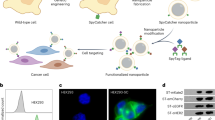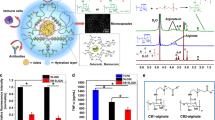Abstract
We report here what we believe is the first example of the encapsulation of hybridoma cells within a synthetic polymer by a simple gelation with dissolved cations in water, and at room temperature. Two lines of hybridoma cells were encapsulated within calcium cross-linked polyphospha-zene gel microbeads without affecting their viability or their capability to produce antibodies. Interaction of these gel beads with the positively-charged poly-electrolyte, poly(L-lysine), of 102-kD molecular weight, produced a semipermeable membrane that was capable of retaining the cell-secreted antibodies inside the beads. Cell density increased 3.5-fold within 13 days concomitant with a 6.4-fold increase in antibody production. These synthetic membranes have the potential to aid in protein recovery schemes.
This is a preview of subscription content, access via your institution
Access options
Subscribe to this journal
Receive 12 print issues and online access
$209.00 per year
only $17.42 per issue
Buy this article
- Purchase on Springer Link
- Instant access to full article PDF
Prices may be subject to local taxes which are calculated during checkout
Similar content being viewed by others
References
Nilsson, K., Scheirer, W., Merten, O.W., Ostberg, L., Liehl, E., Katinger, D. and Mosbach, K. 1983. Entrapment of animal cells for production of monoclonal antibodies and other biomolecules. Nature 302: 629–630.
Scheirer, W., Nilsson, K., Merten, O.W., Katinger, H.W.D. and Mosbach, K. 1980. Entrapment of animal cells for the production of biomolecules such as monoclonal antibodies. Devel. Biol. Standard 55: 155–161.
Al-Rubeai, M. and Spier, R. 1989. Quantitative cytochemical analysis of immobilized hybridoma cells. Appl. Microbiol. Biotechnol. 31: 430–433.
Lim, F. and Sun, A.M. 1980. Microencapsulated islets as bioartificial endocrine pancreas. Science 210: 908–910.
King, G.A., Daugulis, A.J., Faulkner, P. and Goosen, M.F.A. 1987. Alginate-polylysine microcapsules of controlled membrane molecular weight cutoff for mammalian cell culture engineering. Biotechnol. Progress 3: 231–240.
Sinacore, M.S., Creswick, B.C. and Buehler, R. 1989. Entrapment and growth of murine hybridoma cells in calcium alginate gel micro-beads. Bio/Technology 7: 1275–1279.
Iijima, S., Mano, T., Taniguchi, M. and Kobayashi, T. 1988. Immobilization of hybridoma cells with alginate and urethane polymer and improved monoclonal antibody production. Appl. Microbiol. Biotechnol. 30: 264–269.
Kohn, J. 1990. Current trends in the development of synthetic materials for medical applications. Pharm. Tech. 14: 32–41.
Kohn, J. 1990. Pseudopoly (amino acids), p. 195–299. In: Biodegradable Polymers as Drug Delivery Systems Chasin, M. and Langer, R. (Eds.). Marcel Dekker, Inc. NY.
Mathiowitz, E., Salzman, W.M., Domb, A., Dor, P. and Langer, R. 1988. Polyanhydride microspheres as drug carriers. II. Microencapsulation by solvent removal. J. Appl. Polym. Sci. 35: 755–774.
Sugamori, M.E. and Sefton, M.V. 1989. Microencapsulation of pancreatic islets in a water insoluble polyacrylates. Trans- Am. Soc. Artif. Intern. Organs. 35: 791–799.
Cohen, S., Bañó, M.C., Visscher, K.B., Chow, M., Allcock, H.R. and Langer, R. 1990. Ionically cross-linkable polyphosphazene: A novel polymer for microencapsulation. J. Am. Chem. Soc. 112: 7832–7833.
Allcock, H. and Kwon, S. 1989. An ionically cross-linkable polyphosphazene: Poly[bis(carboxylatophenoxy)phosphazene] and us hydrogels and membranes. Macromolecules 22: 75–79.
Cohen, S., Bañó, M.C., Chow, M. and Langer, R. 1990. Lipid-alginate interactions render changes in phospholipid bilayer permeability. Biochim. Biophys. Acta. In press.
Schnaar, R.L., Weigel, P.H., Kuhleuschmidt, M.S., Lee, Y.C. and Roseman, S. 1978. Adhesion of chicken hepatocytes to polyacrylamide gels derivatized with N-acetylglucosamide. J. Biol. Chem. 253: 7940–7951.
Posillico, E.G. 1986. Microencapsulation technology for large-scale antibody production. Bio/Technology 4: 114–117.
Author information
Authors and Affiliations
Rights and permissions
About this article
Cite this article
Bañó, M., Cohen, S., Visscher, K. et al. A Novel Synthetic Method for Hybridoma Cell Encapsulation. Nat Biotechnol 9, 468–471 (1991). https://doi.org/10.1038/nbt0591-468
Received:
Accepted:
Issue Date:
DOI: https://doi.org/10.1038/nbt0591-468



